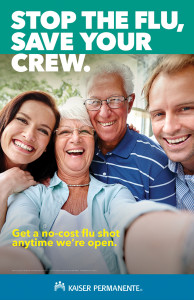Motivating Behavior Change by Tapping into Social Responsibility
Healthcare organizations are now in the population health management business. This requires more than gathering and analyzing patient data, developing care coordination, and network strategies. It also requires comprehensive patient engagement initiatives – programs that not only engage, but also motivate positive actions.
When it comes to influencing consumer behavior, it’s important to uncover the underlying motivators. This demands an awareness of how people make decisions. Studies show that the unconscious mind controls as much as 95% of human behavior. Many behaviors are often predictably irrational. And many habitual behaviors happen largely outside our awareness.
Behavioral science also tells us that most people are unwilling to expend effort today to reduce the risk of a future event they believe is unlikely to happen.
Vaccine Avoidance
Over the next few months, up to 20% of Americans are expected to get the flu. But despite widespread awareness of the flu’s risks, the CDC reports that less than half of U.S. adults get vaccinated each year.
Research shows some people don’t get vaccinated against the flu because of negative perceptions, such as believing the vaccine can cause the flu or other diseases. However, many other people aren’t against the vaccine ─ they just have excuses for not getting it.
The point is, it’s difficult for many people to expend effort to reduce the risk of an event they perceive as unlikely. If they think their chances of getting the flu are low, they can too easily justify avoiding vaccination.
Elevating the Flu Shot to a Social Responsibility
Recently, Kaiser Permanente, one of our healthcare clients, asked for assistance in creating a communications strategy to help boost flu vaccinations among its patient base.
The approach was two-pronged:
- First, make it as convenient as possible to get the vaccine.
- Then leverage the unconscious factors that drive 95% of our decision-making.
The client helped accomplish the first objective by making no-cost flu shots available at walk-in vaccination stations in the lobbies of all its health centers.
For the second, our communications program tapped into people’s inherent desire to do what is socially expected and acceptable. This kind of peer pressure touches every part of our lives, from cutting the lawn because your neighbors cut theirs to donating to a charity supported by your friends.
 Our messaging appealed to a sense of community by pointing out that getting immunized decreases your chance of infecting others. In other words, it’s not just about you. If you carry the flu virus, you can spread it to others even if you don’t feel sick. By getting vaccinated, you protect yourself, your family, your friends, your coworkers.
Our messaging appealed to a sense of community by pointing out that getting immunized decreases your chance of infecting others. In other words, it’s not just about you. If you carry the flu virus, you can spread it to others even if you don’t feel sick. By getting vaccinated, you protect yourself, your family, your friends, your coworkers.
In the first 30 days of the campaign, flu vaccination rates have already increased nearly four times over the previous year.
Tapping into a sense of social responsibility is just one of many behavioral science theories that can be used to develop more effective health communications programs that support patient engagement and motivate positive behavior change. Targeting patients’ true motivations can have a powerful effect on behavior and a real impact on population health management.
This is an excerpt from the article “Effective health care communications for vaccines,” published in the October issue of O’Dwyer’s Magazine.





